|

 Up
Up 
 With the
With the
Wrights iN
America

(You are here.)



  Need
to Need
to
find your
bearings?
Try
these
navigation aids:
If
this is your first
visit, please stop by:
Something
to share?
Please:



|
|
Available in Française, Español, Português, Deutsch, Россию,
中文,
日本, and others.
[Ed. -- This article appeared in Flight
magazine on September 3, 1910. Griffith Brewer was a member of the
Royal Aero Club. He met the Wright Brothers while they were in Europe,
they took a liking to him, and invited him to visit them in Dayton, Ohio.
Brewer wrote this account of his visit for his fellow Englishmen. It's
chatty, somewhat rambling, but it offers a firsthand account of the Wright
brothers at home and at work. In it, he refers to some of the events that
had affected the English aviation community. Foremost among these was the
death of aviator Charles Rolls (co-owner of Rolls-Royce) in a French-built
Wright aircraft. Rolls was the first Englishman to fly the English
Channel, a darling of English society, and his crash put the Wright
aircraft under the microscope.]



|
|
|
By Griffith Brewer
 hen I accepted the hospitality of the Wright Brothers, I had no idea of
publishing the observations of a private visit, nor did I give any hint to
them of such a possibility. It was only after waving farewell at Dayton
Railway Station that the thought developed of giving to my fellow members
of the Royal Aero Club some small idea of what is being done at Dayton, so
that when the pioneers of flight have an opportunity to return to England,
we in the Royal Aero Club may not have followed the general lead like a
flock of sheep, and have shown by our actions and our talk in their
absence, that out of sight from England means also out of mind. I
therefore crave indulgence if the writing of this account is indiscreet,
and I fear it must be so, because it was the only work that could be found
for my hands to do on the voyage back on the " Baltic." hen I accepted the hospitality of the Wright Brothers, I had no idea of
publishing the observations of a private visit, nor did I give any hint to
them of such a possibility. It was only after waving farewell at Dayton
Railway Station that the thought developed of giving to my fellow members
of the Royal Aero Club some small idea of what is being done at Dayton, so
that when the pioneers of flight have an opportunity to return to England,
we in the Royal Aero Club may not have followed the general lead like a
flock of sheep, and have shown by our actions and our talk in their
absence, that out of sight from England means also out of mind. I
therefore crave indulgence if the writing of this account is indiscreet,
and I fear it must be so, because it was the only work that could be found
for my hands to do on the voyage back on the " Baltic."
We are apt to forget in our desire to see flying in general, that we
owe everything to these two American scientists. If it had not been for
their discarding the then accepted scientific data and starting at the
beginning and building up their own tables and diagrams, they might still
have been floundering in endless experiments together with others who have
since been successful. It is no use deceiving ourselves into the belief
that it was the introduction of the petrol engine that gave the Wrights
the opportunity that was denied to others, because when they flew they
carried sufficient margin of power to have flown with the power available
twenty years earlier. In 1892 Maxim built a machine with sufficient power
to fly, but all the modern petrol engines in the world would not be able
to coax that machine to go up in the air today. I am as confident that we
should not be flying to-day were it not for the Wrights as I am that the
pneumatic tire would still be unknown to the world were it not for Dunlop.
I am also confident that if we can get these pioneers of aviation to spare
us some of their attention that the cause of flight in England will be
considerably enhanced. It is therefore with a feeling of pleasant
anticipation that we may look forward to a visit from our American friends
towards the end of the present year.
|
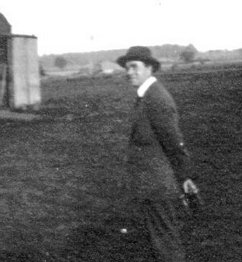
Griffith Brewer at the Wright Flight School. |
The First Mechanical Flights
I never thoroughly realized the absurdity of the so-called mystery of
the early flights made by the brothers Wilbur and Orville Wright, until
this August, when I visited the first flying field. I knew before that the
field was surrounded by a fence, and this fence, with its suggestion of
secrecy, naturally implied a high palisade such as we call fences in
England. Instead, however, of the 6 ft. split-oak palisading to obstruct
the view, I found nothing but a row of low posts, supporting four rows of
wires, to keep the farmer and other wayfarers from looking their fill as
they traveled down the main road between Springfield and Dayton, both
towns of over 100,000 inhabitants. Moreover, if one main road bounding one
side of the ground were not sufficient, then a cross-road bounding another
side of the land afforded equal facilities ; whilst three electric railway
cars per hour also passed along the track adjoining the main road, and
allowed their fifty occupants to view the whole ground, and if
sufficiently interested to alight at " Simms" station, which
abuts directly on one corner of the land rented by the brothers for their
early experiments in 1904, and now used by them to-day as a school for
their pupils.
Newspapers have always been accustomed to receive voluminous copy from
those experimenting with so-called flying machines, the necessity of
giving a full report seeming to most experimenters to be of greater
importance than the accomplishment of something to report on; so when the
two quiet young men squabbled amongst themselves over the theories of
flight during their leisure at home, and put their differences of opinion
to the test outdoors in their vacation, it was natural for the newspapers
to regard these holiday pranks of no serious importance. As it was in 1905
to 1906, so it is today. The work of building machines and testing
alterations is proceeding in the same methodical manner as the development
of a motor launch, and those genial brothers are getting as much fun out
of it as Tom Thornycroft gets in making himself hot and dirty down on the
"Enchantress."
Manufacturing Facilities
I had expected to find the Wright Co. installed in an
up-to-date factory adjoining the flying ground, and Wilbur and Orville
Wright sleeping on beds up amongst the rafters of the shed, and cooking
tasty meals between whiles. Instead I found them living with their father
and sister in the wooden house they had grown up in from the time when
they were all children. The workshop where they make their engines is
within a quarter of a mile, and is the same where six years ago they were
turning out the Wright bicycles which hold their own to-day. Even closer
to the house is the little printing works, where before making bicycles,
they expended their unlimited energy and ingenuity not only in printing a
newspaper, but in making the printing machine, which they constructed out
of pieces of wood and bits of string. This Robinson Crusoe printing press
was only designed for home use, for it invariably refused to go unless one
of the brothers were looking on.
The factory where the flying machines are built is three miles away on
the other side of the city, and there in a large airy ground floor
building some six machines were in various stages of construction. One
machine just on completion attracted my attention, as it enabled me to
compare the tail used by the Wright Brothers in America with the tail
fitted by Mr. Rolls to his French-built Wright machine just before his
fatal accident. The differences in construction were very considerable,
the American pattern being considerably stronger than the French pattern,
whilst a clearance of 11 inches between the propellers and the tail frame
showed a considerable increase in the margin of safety compared, with a 3
in. clearance on the French designed tail. The maximum working strain that
can be brought on to the tail is less than 70 pounds and this tail took
the strain of Wilbur Wright's weight and my own, or over 250 pounds dead
weight on its outer end without bending more than an inch out of line. The
breaking of the tail-frame under wind pressure would, therefore, be
impossible in the American-built machine, and although the French
construction was weaker, it is extremely improbable that the tail on Mr.
Rolls' machine collapsed under wind pressure.
|
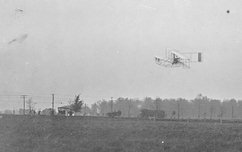
Wright airplane above the Interurban that ran past
the Wright Flying School.
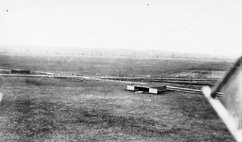
The Wright flying field from the air.
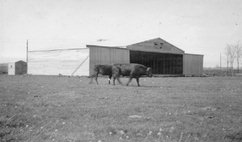
The hangar at the Wright flying field in 1910. This is
much larger than the original 1904 hangar.
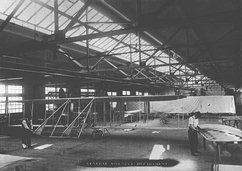
The assembly room at the Wright Company Factory.
|
Mr. Rolls’ Accident
The propellers probably fouled the frame of the rail and cut through
the lower members, but how the frame approached sufficiently to take up
the three inches clearance, whether by bending or disconnecting, will
never be known. Although it is certain that the tail frame broke in the
air, it is by no means certain that this was the cause of the main
accident, The wind was blowing towards the grand stand, and would be
rising in a wave over it, and in commencing the dive towards the target
the machine would be running down at an angle in a rising current. Most of
the weight of the machine is between the main planes, and when the machine
entered the lower strata of air this would be traveling horizontally, and
would catch the elevating front planes on their upper side, thus tending
to still further increase the downward angle of travel, irrespective of
the angle at which they might then be set. The inertia of the weight,
would, however, maintain the forward direction of the heaviest part, and
assist the completion of the vertical movement. Rolls attempted a daring
maneuver, just as a hundred times previously he had dared some feat in
motoring or ballooning, but on this occasion the risk he took prevailed.
The fact that the Wright Brothers neither designed nor authorized the tail
fitted to Mr. Rolls' machine does not therefore appear to he of much
importance, because, no matter what machine had been flown and brought
into that diving position in the wind wave before the grandstand, the
result must have been the same.
|
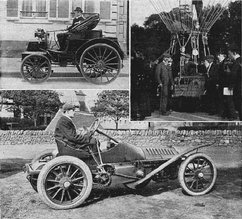
Charles S. Rolls with some of his passions.
|
Pupils Learning to Fly
The flying ground used by the Wright Brothers is situated about eight
miles west of the city of Dayton, at a small station called "Simms
" on an electric car line between Dayton and Springfield. The cars,
which are as large as Pullmans, leave the main street in Dayton on the
ordinary city tram rails every half-hour, and in twenty minutes drop their
crowd of aviators and spectators on the main road which runs alongside the
rough weed-grown field. Every morning at breakfast the telephone used to
ring, and the same answer suited all inquirers, "Well, you are as
likely to see a flight today as any other day. The Wright Brothers don't
know themselves whether there will be any flying," and this
explanation was literally true. They never knew, any more than other
inventors, what stage of the designing, testing, or experimenting they
would reach that day. After the first day's visits to the factory and the
workshop I generally remained at home, until Wilbur or Orville came
running in to say they were going out, to Simms on the next car. If the
weather was fine, then we had to fight our way on to the car, Orville
generally riding on the step because of the crowd going out to see the
"airship proposition." Why does the man in the street
muddle the "airship" with the "aeroplane?" He does not
muddle a lifebelt which enables him to float in the water with a pair of
skates for gliding on the surface; but perhaps he did make this mistake
when skates were first invented.
On arriving at. Simms we cross a plank bridge over a ditch, pass
through a little wicket gate and enter the back of the shed where two
machines are standing. One is on skids and the other has auxiliary pairs
of wheels attached to the skids. Mr. Coffyn is in charge of the school,
and his other pupils, Messrs. Brookins and Johnstone, are tinkering with
the machines preparatory to making trial flights. Both machines have
adjustable tail planes attached, and one has had the two front planes
removed and the "blinkers" have been nailed temporarily to the
front framing. This frontless machine is the first to be- taken out and we
pull it out on to the smoothest part of the rough ground, where weeds as
still and high as young willows cover most: of the land. Then the engine
is started up, and before I know what is about to happen there is Orville
riding up in the air on the machine without its bridle. "They'll be
going up soon on the engine alone with half a propeller," remarks the
man who hands back my cap across the fence where it has been blown by the
wind from the propellers. After a short three minutes' flight Orville is
down again to make some adjustments, and then in another -seven minutes is
up for a second trial. They have a simple homemade range-finder al Simms
composed of a wooden yardstick and a little metal slide on it having two
pairs of prongs projecting from it at 1 inch. and ½ inch apart
respectively. You point the stick and sight it at the machine as it flies
overhead, and run the slide out until the prongs enclose the wings
exactly. Knowing the wings to be about 40 ft. wide, and assuming the
1-inch prongs fit at 10 inches. distance down the stick, the height of the
machine is approximately 400 feet. One of the first flights that I saw
measured by Wilbur in this way gave Orville a height of 1,200 ft.
|
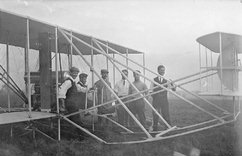
Orville and some of his first student pilots.
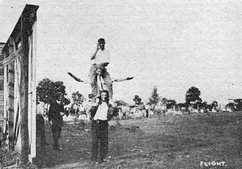
Brookins, Coffyn, and Johnstone clowning around.
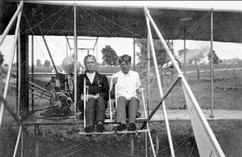
Brewer in the cockpit of a Wright airplane with a
student pilot.
|
More Flights and "Stunts"
My second visit to Simms was a pupils’ day, commencing with Brookins
going up and doing "stunts " for my benefit. He turned many
circles in less than ten seconds each, and the banking angle to which the
machine was brought in these quick turns was 45 degrees at the least. On
expressing surprise at these quick revolutions, I am told that he has
turned a complete circle in less than seven seconds, but has been
instructed not to do so quick a turn again before the strains brought onto
the machine, and which exceed twice the ordinary flying strain, have been
accurately figured out. This Brookins is a promising kind of pupil, and
holds the world's record for height, having flown under official
observation 6,175 feet. This was done early in July at Atlantic City when
he won 1,000-English-pound prize [$2500] for beating all officially
certified high flights. Brookins seemed too daring, and I told him that I
for one would not care to experience the exhilaration of a flying trip
with him.
A new pupil is to be taken up for the first time, and Orville decides
to take him instead of leaving him to Brookins. "I guess he was
afraid I'd scare him too much for a first trip," says Brookins as
they fly overhead, the novice squeezing the sap out of the upright, to use
the parlance of the expert flyers of two months standing. It is well to
notice here that Brookins, who had never seen a flying machine three or
four months ago, has found no difficulty in mastering the
"complicated Wright Flyer" and capturing a world's record on it.
Before I left ten days later, the novice, Parmalee, was using both levers,
and told his instructor that he thought he had nearly got the hang of that
"double-jointed lever." After this lesson Johnstone was sent up
for a practice flight of an hour, sufficient petrol being put into the
tank to cover the hour, but insufficient to tempt him to make a record for
endurance- At the end of an hour and thirty-four minutes he came down with
the petrol finished. The day terminated by Coffyn making two 2-minute
flights, the second being terminated by signal, so that we might all catch
the next tram home. This time I stood on the step and Wilbur and Orville
got jammed somewhere in the vestibule. Brookins and Johnstone hung on to
the buffer and cowcatcher outside, whilst the spectators sat it out
comfortably on the seats.
And so the days flew by. Crammed full of interest from the time of
eating the cantaloupes in the morning, to the sitting out on the veranda
after dinner at night, when the brothers talked horse-power and wind
surfaces, while I watched the fire-flies and got in the way of the
arguments as little as I could. And I don't think the pleasure was all on
my side. All the Wright family seemed out for fun, and each member worked
hard to get it. Even Bishop Wright at the age of 82 wants his share, and
when Orville took his venerable father for a ride aloft, he had to mount
to many hundreds of feet in compliance with his passenger's requests to go
up higher. This enthusiasm also struck others, for the lighthouse keeper
at Kitty Hawk said he had never seen men work so hard for fun before.
|
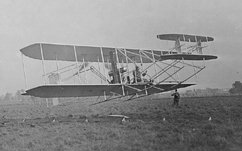
Launching a Wright airplane.
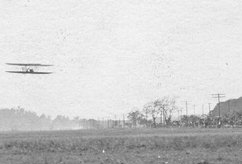
Crowds watching the flights at the Wright flying
field.
|
A Ride on the Wright Flyer
Those who have been favored with a ride with Wilbur or Orville have
never had previous warning. The simple question, "Are you ready for a
ride?" has now been put to several, and I have never yet heard of its
being refused. At Le Mans, when Wilbur rewarded the " "English
bunch" for their enthusiastic patience, he took all four of us up one
after the other, these Aero Club members all having instantly answered
"Yes" to this welcome invitation. So when Orville put the same
gratifying question to me at Simms I stifled my determination to keep out
of the way so as to let them get on with their work, and took my place on
the central seat next to the engine. This time we were to fly with one
elevator plane detached, and with the right-hand blinker only. We also
tried the experiment of running through the long weeds before the wind;
but, although we succeeded in decorating the machine with green, and
taking on board a cargo of grasshoppers, we made the first and only false
start. My weight has gone up since my last trip, but it is still below
that of one of my rival butterflies at Le Mans. A second attempt, in the
opposite direction was more successful, and we began to climb up stepless
stairs as we went round the field. Out of consideration for my novice
feelings Orville refrained from anything in the way of "stunts,"
although he look the machine round some beautiful curves, and up to about
400 ft., where the air was delightfully warm as distinct from the damper
air near the ground. Then we slowed the engine down to walking pace, and
slid down an elastic slope to the level of the tree-tops, when we
quickened up and ran through the weeds, collecting their tops on the
skid-stays without the wheels or skids touching the ground. Perhaps
they'll add a scissors attachment below the machine, and use it as a
reaper later on.
|

Brewer flying with Orville.
|
A "Hole in the Air"
Up into the air again, waving a greeting in return from those at the
shed, and later at the other end of the field we ran into the "hole
in the air" that has been referred to by many aviators. Mr. Paulhan
told me that in his flight to Manchester he encountered such a hole, and
the machine fell some 30 ft. before recovering its airy support. My
experience was mild compared to this. We were running quite smoothly when
the seat seemed to give way, and it was quite an appreciable moment before
I felt I could sit on anything solid. Looking to Orville on my left, I met
his reassuring smile, and we went smoothly on to inspect neighboring
cornfields and cut a few eights as a fitting termination to a 23-minute
flight. They say the particular spot where we had the "little
drop" is in a corner of the field where it is quite usual to
encounter similar whirls or disturbances. The machine did not pitch or
oscillate, but simply went down bodily about two feet.
|
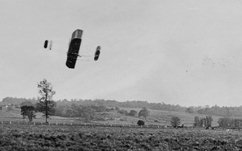
Banking the airplane over the flying field.
|
More Pupils and Workshop Observations
Alter my own flight, other flights seemed to be of less consequence,
but they went on just the same. Each pupil did his "stunt," and
each instructor reflected how green he must have been a month before when
he was only a pupil. The days when we did not go out to Simms brought in a
report from Coffvn giving a list of flights by the various pupils, and the
brothers went on in their leisurely, get-there way, designing, thinking,
making and testing — not testing to find out, but testing to prove
conclusions already arrived at. At the works one morning I noticed an
engine running by itself and turning an arm giving similar resistance to a
pair of propellers. This engine, which seemed to have been forgotten, was
still running later in the afternoon when I went there again, so I
inquired, and found that it had been started at 8 a.m., and with the
exception of the lunch hour, it had been running all day without attention
and would run like that. till 5:30. Why do we have such engine troubles in
Europe, and why can’t we get our engines to run like they invariably do
in America. Is it because: the Americans slave to work so much harder
across the Atlantic, and that their engines out of sheer force of example
do the same?
And so they go on day after day, gaining the love and respect of their
pupils and all with whom they come in contact. Just as it was at Le Mans
and Pan, where their influence was more far-reaching than in the cause of
flight alone.
|
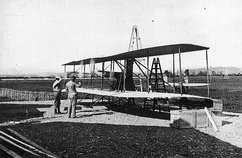
Testing an engine installed in the wing section
of a new Wright aircraft.
|
The Wright Patent Litigation
Before closing, let me say a few words to explain the present situation
of the Wright patents. Both in America and England the courts have power
to issue an interim injunction restraining infringement of a patent, in
which it is shown to the satisfaction of the Court, that infringement is
taking place and that damage will be incurred if the continued
infringement is not restrained. It is, however, extremely rare that such a
power is exercised before the hearing of the trial, when the witnesses are
examined. The validity of the patent was not disputed, and the judge,
after consideration of the documents in the case, decided that the
infringement was so obvious that he granted the interim injunction. The
defendant appealed, and filed additional documents, and the Wright Co.
considering the new documents to be unimportant, did not apply to refer
the new documents to the first court, but, in order to save time, went
directly to the Court of Appeal. The latter held that they could only
consider the judgment of the court below, and they could not go into the
merits of the case as affected by new document. In view, therefore, of the
fact that the new documents were now on the record, but had not been
before the first court, the Appeals Court could not support, the
injunction on the unconsidered documents, and, therefore, the interim
injunction must be quashed. There can be no doubt that the Wright Co. will
win their action, seeing that their case was strong enough to enable them
to obtain an injunction in the same Court before. The parties are now in
the same position as if the injunction had never been obtained, and the
trial in the first court will come on for hearing at the end of the year
in the ordinary way.
|
|
|
|
|